Smiths two-inch auxiliary gauges.
Many cars of the 1950s and 1960s came with auxiliary gauges as standard, and of them, a large percentage were produced by Smiths Industries. Other companies suppling this type of gauge in the 1960s included AC, Jaeger, Lucas and Veglia, but this page takes a look at some of the classic two-inch diameter Smiths gauges that were either fitted as standard - usually to middle or upper range cars - or were fitted by enthusiastic owners, looking to improve their car's specification and/or monitor their engine's condition more closely. This was especially true of owners who were not satisfied with a manufacturer's standard array of dashboard warning lamps, and sought advance warning of impending mechanical malfunction by the use of aftermarket dials.
|
|
A leaflet I found from the late 1960s features several examples of Smiths gauge, plus instructions on how to fit them. Most types I'd come across before, and I've quite a few different ones dotted around my own garage, some of which I've used on cars in the past. One or two though I've yet to encounter. Over time I hope to add to this initial selection of instruments, with examples of Smiths products from earlier times, but for now, here are some of the products that 1960s-motorist could well have been tempted into buying and fitting to his or her Mini, Anglia, Imp or Cortina.
|

|
Supplementary instruments of the 1960s.
Here are eight different Smiths instruments, accompanied by a brief description. Anyone building a modified car from this era might want to look out for this style of gauge to keep their dashboard looking period-correct, they turn up on ebay regularly (for example oil pressure , ammeter and temperature gauges to name a few).
|
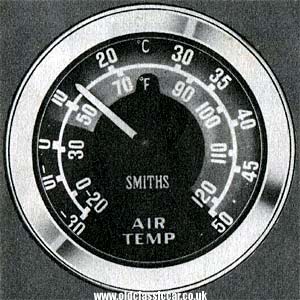
|
Air temperature (code ATC).
I've a few 2-inch diameter water temperature gauges, but I've yet to stumble across an air temperature version. With scales in both Celsius and Fahrenheit this, like all dials of this type, could be fitted to any dash by utilising a suitable bracket bolted or screwed to the lower edge of the dash panel, as can be seen fitted to the Ford Prefect shown above. The ambient temperature was monitored by a reading taken from a sensing unit, or bulb, clamped in place behind the car's front bumper in such a way that it wasn't affected by air flow passing over and under the car, and also by the heat emanating from the radiator. Connecting the sensor to the gauge was a capillary tube, not unlike that found on the more common water temperature monitors.
|

|
Clock (codes CBP, CBN, CFP, CFN, CRP, CRN).
Whereas car clocks are fitted to virtually all new cars today, in the 1950s and 1960s this wasn't always the case. To remedy this, clocks of the standard 2-inch dimensions were offered by many aftermarket parts suppliers. This one features the usual white lettering on a black background, surrounded by a chrome bezel. Anyone looking to buy these gauges will need to check them carefully, as some have bezels with a rounded profile to them, whereas others - like the one illustrated - have a more pronounced peak, or crease, to their profile. This example was suitable for 12 volt systems only, and versions designed for both positive- and negative-earth systems were available.
|

|
Vacuum / Performance (codes VB, PF).
The vacuum gauge took its feed from the car's inlet manifold, into which a hole had to be drilled and then tapped out to 1/4" BSF. While the vacuum-only monitor shown alongside had the standard white-on-black appearance, a "performance" gauge also offered by Smiths had a series of coloured bars on it, designed in such a way as to monitor the driver's habits and encourage a more economical style of driving. Typically, the harder an engine was worked, the lower the reading would be. The red section for example covered the 0-5 ins. hg. range, and was usually encountered during heavy acceleration or under load. At the other end of the scale was yellow, for 21-30 ins. hg., where the throttle was closed, the engine on the over-run. It was recommended that this state shouldn't be maintained for great lengths of time, as it could lead to oiling-up of the spark plugs and unusually-high oil consumption in a tired engine. The ideal range for maximum economy was in the 18-21 ins. hg. range, ie the green band.
|
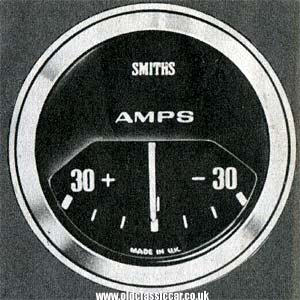
|
Amps (codes AB, ASB, ABA).
Most cars fitted with extra gauges would have had an ammeter included in with the upgrade. This particular example had the needle located at the top of the instrument face, pointing downwards to a scale that read from +30 to -30. New cars of that era tended to have alternators rather than dynamos, and as such were capable of greater charge rates. Equivalent dials from the 1930s and 1940s may only have read from +20 to -20.
|
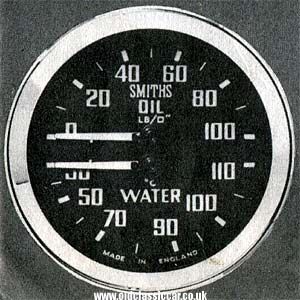
|
Oil pressure & Water temperature combined (code DB).
Where space to mount gauges was tight, then combining two gauges into one made sense. This code DB instrument combined mechanical oil pressure and water temperature gauges into one single unit. Separate water and oil gauges were also available, coded TB/TSB and PB/PSB respectively. The water monitor, as with the air temperature monitor referred to already, utilised a bulb-shaped sensor, in this instance plumbed into the car's cooling system. The oil gauge was connected to a suitable feed in the engine by a copper pipe, often taking its feed from where the low oil pressure warning lamp sender was located.
|

|
Oil pressure (codes PB, PSB).
Some oil pressure gauges had a face not dissimilar to that of a clock, with the needle located in the centre of the dial face, while others - like this one - have a needle mounted towards the top, pointing downwards. This example red from 0-100 psi. Use of a T-piece at the engine end of the feed pipe would enable the low pressure warning light, usually fitted to a car's dashboard as standard, to work in parallel with the gauge.
|
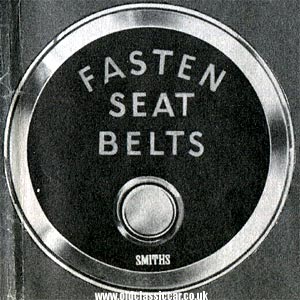
|
Fasten seat belts (code SB1).
As the fitment of front seat belts increased during the 1960s, so too did the number of people forgetting to actually use them. A single electrical feed was wired up to the rear of this reminder. Whenever the car's ignition was switched on, the FASTEN SEAT BELTS warning would illuminate in red. Putting on one's seat belt didn't extinguish the lamp, as it wasn't possible to detect whether a three-point inertia reel belt, or a static two-point lap belt for instance, had been used. A button in the centre of the instrument had to be pressed to put out the message.
|
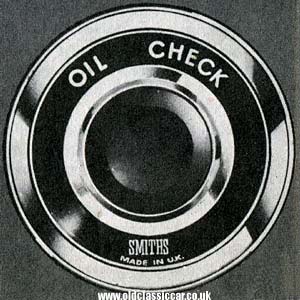
|
Oil check (codes OC1, OC2, OC3).
The only time I've come across one of these oil level checkers was when a loose one fell out of a box of parts, that came with a Rover P5B I once had. Included in the fitting kit was a replacement dipstick, on which a simple form of calibration had to be undertaken, using the engine's original dipstick as a reference. Basically, an adjustable clip at the top of the new dipstick was positioned in line with the lower shoulder of the original, ie where it pushed in and rested against the engine block. A drilled hole near the base of the new dipstick had to align with the mid-way point between the MINIMUM and MAXIMUM markings on the original. The replacement could then be installed in the engine, and a nylon connecting tube fed up through the bulkhead, to the oil check unit. Pulling the knob on the Smiths oil check would result in either a red reading, suggesting that the level was getting low, or else a green reading suggesting that the level was still acceptable.
|
|
Only these eight instruments are illustrated in this late-60s leaflet, although mention is also given to the Battery Condition Indicator (or Voltmeter, code BC), and the company's range of impulse tachometers (codes IT4, IT4C, IT6, ST4, ST6).
|
|
I plan to photograph and include here other examples of 2" Smiths gauge, to demonstrate the variety of dial styles that have featured on this firm's products over the years. A leaflet advertising similar gauges on offer at the time, from Siran Ltd, can now be found here.
|













